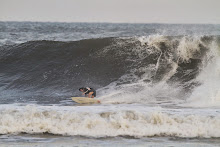Last night, John and I dove on the cage that Dan and I had deployed the day before. Fear and loathing in my heart. I noticed the gaps in the cage doors the day before, and figured those busy-body sea hares would just march right through them. When John arrived from the mainland, I bitched and moaned about the gaps as we started making the second cage. Different people around the Marine Lab had different suggestions. A student in the CSU zoology class out here suggested we just make it so the meshes overlap when the door is closed. The doors don’t really close like that. They are on loose zip-tie hinges, not solid ones. I got the idea of sewing a drawstring to the hatch and having a little Santa bag entrance to the cage to put rocks and lobsters in and out. The driver for the supply boat said cut some hose lengthwise and put them on the PVC to make a tighter fit.
We tried the last idea. It worked great in our as yet undeployed cage 2. Now, there are no gaps bigger than a finger. So we decided to take the idea down to the already deployed cage.
So how do you plan a dive, when you have no idea what will greet you when you drop down there?
Will the cage be ripped to shreds like the last time? If so, let’s pull it up and bring it back to dry land and get drunk.
What if it only has one hole? Ok, we mend it underwater.
What if all 5 sea hares escape? We put on the hoses and come back to the dock and get more sea hares.
What if 2 sea hares escape? We put on the hoses and go find an attacking lobster.
What if zero sea hares escape? We put on the hoses and go find an attacking lobster.
What if we can’t get the hoses on underwater? We take off the doors and ascend to the whaler and work on them there. Then go find an attacking lobster.
We take the whaler over to Siwash, jump in the water with our gear on, and descend down to the cage.
Guess what? All 5 sea hares are there. 3 of them were on the walls of the cage, 2 of them on the rocks, feeding on the algae.
Hurray!
John and I flash reciprocal “OK” signs (understatement) and get busy. Wrassle stubborn half-split hose onto the four sides of the PVC. Wrassle little zip ties through the fine Pet Screen mesh to secure the hose to the PVC. John and I each working on one gate, furiously. Knowing if we delay too much, we won’t have enough air to find an attacking lobster. Within 20 min the job is done. Check on the sea hares again, and now, let’s go find an attacker!
Why is it that when you really need a taxi quick, they are never around? Lots of little guys running around, but none of the tanks we’ve regularly seen. We try a few. Some half-hearted pounces, but none of the committed attacks we have grown so familiar with. We start by heading out toward the point, but then I change my mind. I’m thinking we have to get back into the core of the preserve. We don’t know, maybe people are poaching out here, even. So, I turn and head back. We go for a long time seeing very few lobsters. Getting nervous. When you aren’t in the middle of doing something, but just swimming, you start to think about monsters. Goddamnit, where are the lobsters??
Then I see a tank. Finally. Wiggle my light at John. He comes over, red light on the lobster. I take a sea hare out of my game bag and offer it up to the lobster. Full-blown attack. Ink flying everywhere. Lobster marching with his prey to another den. Signal John to “get him”. John has really learned how to catch a lobster with high probability out in the open. The key is to avoid the antennae. If the bug has his antennae laid back, you just have to wait. This one was trucking along with his inking sea hare under his mouth. Finally he slows down. John moves in. Lots of kelp in the way. Not a great shot. He lunges, pins the puppy to the bottom. 5 million bubbles come up from my sigh of relief.
He has the lobster clutched to his chest. It is MY job to now figure out where the cage is. I’ve gotten better at keeping track of my location. And there are a couple of landmarks at this spot. So there it is right there. We swim over. John carefully pulls the lobsters legs off his chest without breaking them. Puts the bug into the cage. Then he fastens the hatch, we signal ok, then thumbs up means we head to the surface.
I don’t think I’ve ever felt so good after a dive. We congratulate each other, put our gear away, eat a big omelet, and go to bed.

No comments:
Post a Comment